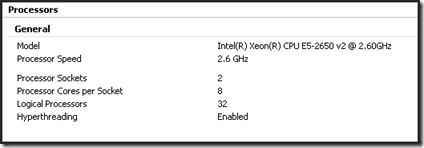理清Processor, Processor Sockets, Processor Cores, Logical Processors, Hyperthreading这些概念吧
如果你只知道CPU这么一个概念,那么是无法理解CPU的拓扑的。事实上,在NUMA架构下,CPU的概念从大到小依次是:Node、Socket、Core、Logical Processor。
随着多核技术的发展,我们将多个CPU封装在一起,这个封装一般被称为Socket. 也就是物理处理器插上的地方, 看起来像这样:
Socket中的每个核心被称为Core。
为了进一步提升CPU的处理能力,Intel又引入了HT(Hyper-Threading,超线程)的技术,一个Core打开HT之后,在OS看来就是两个核,当然这个核是逻辑上的概念,所以也被称为Logical Processor.
那么问题来了, 假设我拿到了一个VMware vSphere的key, 其类型为'VMware vSphere 5 Enterprise for 16 processors'. 那么这里被限制的是16个socket, 还是core, 还是logical processor?
还有, 如果我是这样的一台服务器, 那么我是否会被这个license所限制?
网上搜索的这篇文章中有如下的一句:
Update september 2012: starting with version 5.1 VMware repealed the vRAM model. Nor the amount of RAM, or the number of CPU cores matter. Licensing is now done simply by the number of CPU sockets.
这样看起来, 那么我的这台服务器只有2个socket, 没有超过16个sockets的上限, 应该是没有被限制的.
参考资料
============================
CPU Topology
http://kodango.com/cpu-topology
Understanding Non-uniform Memory Access
http://technet.microsoft.com/en-us/library/ms178144(v=sql.105).aspx
Windows Server - Sockets, Logical Processors, Symmetric Multi Threading
VMware vSphere 5 Editions Overview
http://www.thomas-krenn.com/en/wiki/VMware_vSphere_5_Editions_Overview

